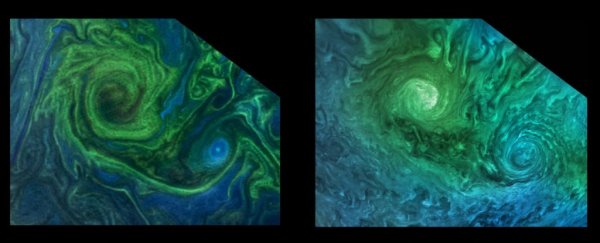Earth and Jupiter don't have a lot in common.
One is relatively small, rocky, and habitable. The other is absolutely enormous, completely lacking in solidity, and raging with colossal storms. Yet, if you look at some satellite pictures of marine phytoplankton blooms here on Earth next to pictures of atmospheric turbulence at Jupiter's poles, it can be hard to tell them apart.
It's a striking similarity, and one that has finally led us to an answer as to what causes Jupiter's spectacular turbulence: moist convection. This is when warmer, less dense air rises, and even at the small scale, it's enough to cause huge cyclones on our Solar System's biggest planet.
And, fascinatingly, it took an ocean scientist to make the connection.
"When I saw the richness of the turbulence around the Jovian cyclones with all the filaments and smaller eddies, it reminded me of the turbulence you see in the ocean around eddies," said oceanographer Lia Siegelman of Scripps Institution of Oceanography.
"These are especially evident on high-resolution satellite images of plankton blooms for example."
 Vortices on Earth and Jupiter. (NASA OBPG OB.DAAC/GSFC/Aqua/MODISImage/Gerald Eichstädt)
Vortices on Earth and Jupiter. (NASA OBPG OB.DAAC/GSFC/Aqua/MODISImage/Gerald Eichstädt)
Moist convection was proposed as the mechanism behind Jupiter's turbulence some time ago, but we didn't have access to the sufficiently detailed data needed for a confirmation. Then Juno arrived on the scene. Its orbit around the gas giant took it around the poles, allowing us the first detailed views of these turbulent regions.
There, scientists saw peculiar clusters of cyclones 5,000 kilometers (3,100 miles) across, with smaller scale vortices and filaments, from 100 to 1,600 kilometers.
Juno is equipped with two cameras – optical and infrared – at resolutions down to scales of 10 kilometers. Siegelman and her colleagues analyzed Juno's images of the gas giant's north pole, using the sequences of optical images to track the movements of the clouds, which in turn gave estimates of wind speed and direction.
The infrared images allowed them to see the temperatures of these images; hotter regions represent thinner clouds, and cooler ones represent thicker clouds.
 Turbulence on Earth and Jupiter. (NASA OBPG OB.DAAC/GSFC/Aqua/MODISImage/JPL/SwRI/MSSS/Gerald Eichstädt)
Turbulence on Earth and Jupiter. (NASA OBPG OB.DAAC/GSFC/Aqua/MODISImage/JPL/SwRI/MSSS/Gerald Eichstädt)
This level of detail allowed the team to figure out how the turbulence occurs. They found that rapidly rising convective upwellings of hot, less dense air from origins less than 100 kilometers across transfers energy upwards into the giant cyclones, feeding and sustaining them. (Although, to be perfectly clear, we still don't know what makes these cyclones start.)
This type of energy transfer hasn't been observed on any other planet. Interestingly, it resembles idealized studies of rapidly rotating Rayleigh-Bénard convection; that's convection in which a horizontal lower layer of fluid is heated and rises into the cooler layer above. This similarity supports the model of moist convection in the Jovian polar cyclones.
This finding started with Earth and an uncanny similarity between our home planet and Jupiter. It also boomerangs back to Earth: it might be able to provide some insights into our own atmospheric processes, the researchers said. Wind observations taken here on Earth show a similar kinetic energy spectrum to the Jovian observations, which suggests that very similar energy transfer may be occurring on both planets.
"To be able to study a planet that is so far away and find physics that apply there is fascinating," Siegelman said. "It begs the question, do these processes also hold true for our own blue dot?"
Future investigations will be needed in order to confirm this, but it could ultimately contribute to a better understanding of our home planet.
The team's research has been published in Nature Physics.
